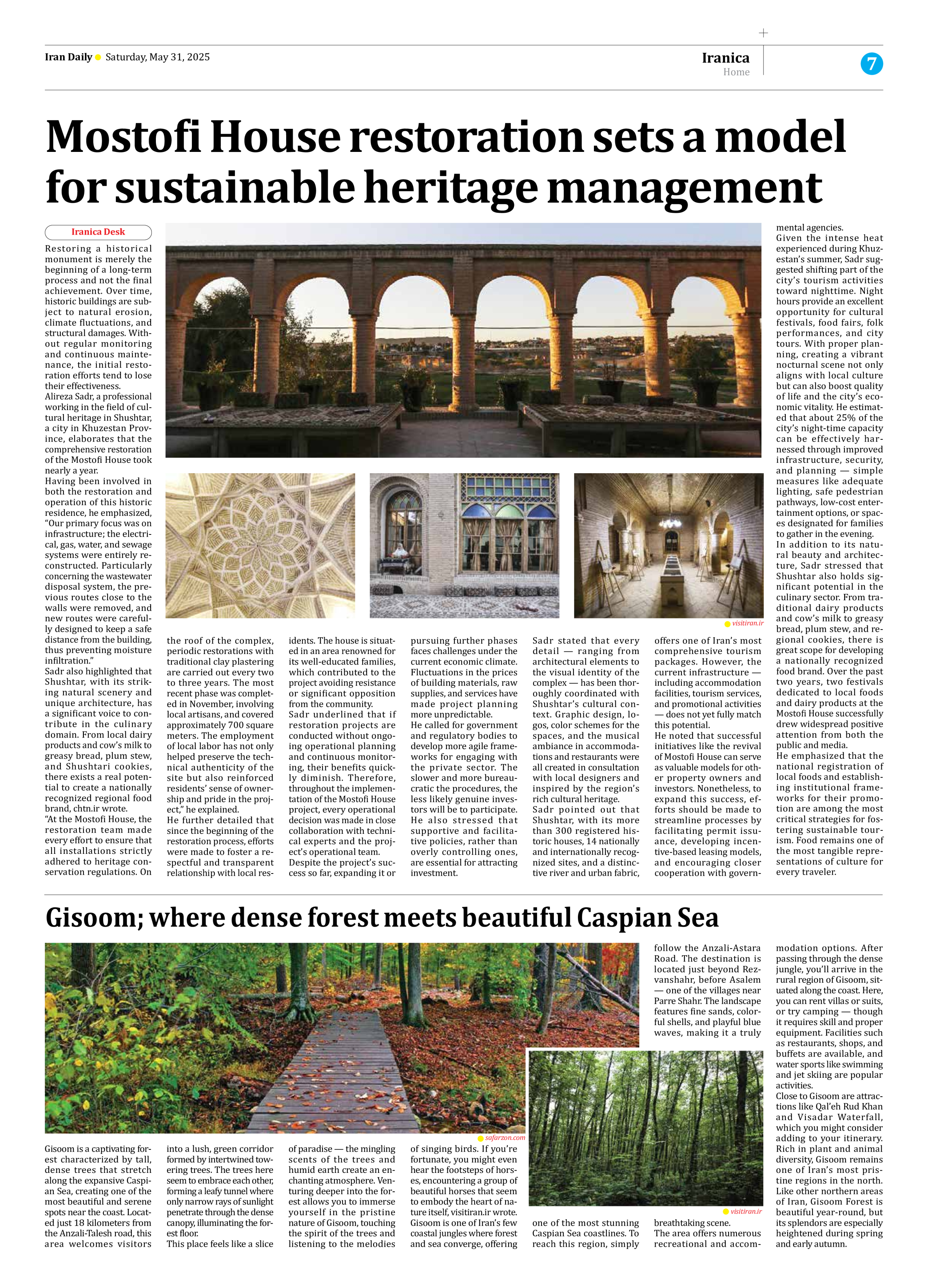
Mostofi House restoration sets a model for sustainable heritage management
Restoring a historical monument is merely the beginning of a long-term process and not the final achievement. Over time, historic buildings are subject to natural erosion, climate fluctuations, and structural damages. Without regular monitoring and continuous maintenance, the initial restoration efforts tend to lose their effectiveness.
Alireza Sadr, a professional working in the field of cultural heritage in Shushtar, a city in Khuzestan Province, elaborates that the comprehensive restoration of the Mostofi House took nearly a year.
Having been involved in both the restoration and operation of this historic residence, he emphasized, “Our primary focus was on infrastructure; the electrical, gas, water, and sewage systems were entirely reconstructed. Particularly concerning the wastewater disposal system, the previous routes close to the walls were removed, and new routes were carefully designed to keep a safe distance from the building, thus preventing moisture infiltration.”
Sadr also highlighted that Shushtar, with its striking natural scenery and unique architecture, has a significant voice to contribute in the culinary domain. From local dairy products and cow’s milk to greasy bread, plum stew, and Shushtari cookies, there exists a real potential to create a nationally recognized regional food brand, chtn.ir wrote.
“At the Mostofi House, the restoration team made every effort to ensure that all installations strictly adhered to heritage conservation regulations. On the roof of the complex, periodic restorations with traditional clay plastering are carried out every two to three years. The most recent phase was completed in November, involving local artisans, and covered approximately 700 square meters. The employment of local labor has not only helped preserve the technical authenticity of the site but also reinforced residents’ sense of ownership and pride in the project,” he explained.
He further detailed that since the beginning of the restoration process, efforts were made to foster a respectful and transparent relationship with local residents. The house is situated in an area renowned for its well-educated families, which contributed to the project avoiding resistance or significant opposition from the community.
Sadr underlined that if restoration projects are conducted without ongoing operational planning and continuous monitoring, their benefits quickly diminish. Therefore, throughout the implementation of the Mostofi House project, every operational decision was made in close collaboration with technical experts and the project’s operational team.
Despite the project’s success so far, expanding it or pursuing further phases faces challenges under the current economic climate. Fluctuations in the prices of building materials, raw supplies, and services have made project planning more unpredictable.
He called for government and regulatory bodies to develop more agile frameworks for engaging with the private sector. The slower and more bureaucratic the procedures, the less likely genuine investors will be to participate. He also stressed that supportive and facilitative policies, rather than overly controlling ones, are essential for attracting investment.
Sadr stated that every detail — ranging from architectural elements to the visual identity of the complex — has been thoroughly coordinated with Shushtar’s cultural context. Graphic design, logos, color schemes for the spaces, and the musical ambiance in accommodations and restaurants were all created in consultation with local designers and inspired by the region’s rich cultural heritage.
Sadr pointed out that Shushtar, with its more than 300 registered historic houses, 14 nationally and internationally recognized sites, and a distinctive river and urban fabric, offers one of Iran’s most comprehensive tourism packages. However, the current infrastructure — including accommodation facilities, tourism services, and promotional activities — does not yet fully match this potential.
He noted that successful initiatives like the revival of Mostofi House can serve as valuable models for other property owners and investors. Nonetheless, to expand this success, efforts should be made to streamline processes by facilitating permit issuance, developing incentive-based leasing models, and encouraging closer cooperation with governmental agencies.
Given the intense heat experienced during Khuzestan’s summer, Sadr suggested shifting part of the city’s tourism activities toward nighttime. Night hours provide an excellent opportunity for cultural festivals, food fairs, folk performances, and city tours. With proper planning, creating a vibrant nocturnal scene not only aligns with local culture but can also boost quality of life and the city’s economic vitality. He estimated that about 25% of the city’s night-time capacity can be effectively harnessed through improved infrastructure, security, and planning — simple measures like adequate lighting, safe pedestrian pathways, low-cost entertainment options, or spaces designated for families to gather in the evening.
In addition to its natural beauty and architecture, Sadr stressed that Shushtar also holds significant potential in the culinary sector. From traditional dairy products and cow’s milk to greasy bread, plum stew, and regional cookies, there is great scope for developing a nationally recognized food brand. Over the past two years, two festivals dedicated to local foods and dairy products at the Mostofi House successfully drew widespread positive attention from both the public and media.
He emphasized that the national registration of local foods and establishing institutional frameworks for their promotion are among the most critical strategies for fostering sustainable tourism. Food remains one of the most tangible representations of culture for every traveler.







